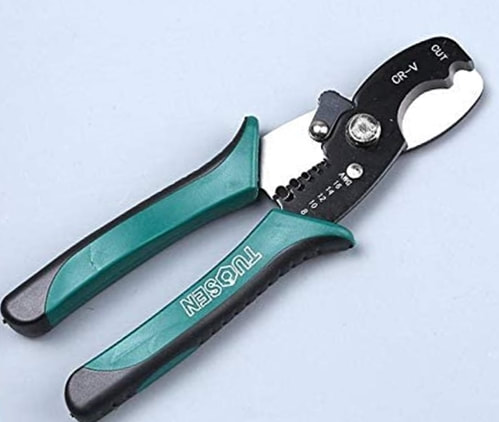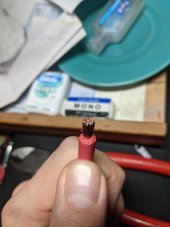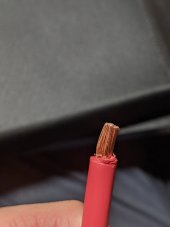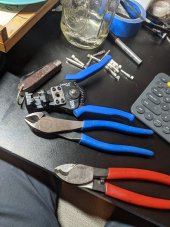You are using an out of date browser. It may not display this or other websites correctly.
You should upgrade or use an alternative browser.
You should upgrade or use an alternative browser.
wire stripping for crimping: how much wire loss is tolerable
- Thread starter starchy
- Start date
timselectric
If I can do it, you can do it.
- Joined
- Feb 5, 2022
- Messages
- 18,531
That would depend on how close the load is to the wire rating.
timselectric
If I can do it, you can do it.
- Joined
- Feb 5, 2022
- Messages
- 18,531
I would de rate the wire by 5%. If, it's not close on load. You should be fine.
Those wires will break over time, it is already a weak spot and at a high stress location, it will only get worse over time.
Redo the crimp and do not cut so deep next time, just bend the wire a little and the plasitic will break off. in addition add heat shrink to provide some more stability at the joint.
Redo the crimp and do not cut so deep next time, just bend the wire a little and the plasitic will break off. in addition add heat shrink to provide some more stability at the joint.
It's best to use the proper tools. A good set of wire strippers is important and not very expensive. Will has a tools page:

Scroll down to his recommended precision wire stripper ($30). I got the same one and it works really well. I tend to use the cutter for the next larger wire to ensure not wire strands are damaged. For example, if I'm trying to strip a 16AWG wire I use the 14AWG cutter.

Tools
Do not buy cheap tools. You will thank yourself for years, and building a system will be MUCH EASIER. ( I make a commission for purchases made through the links below)
www.mobile-solarpower.com
Scroll down to his recommended precision wire stripper ($30). I got the same one and it works really well. I tend to use the cutter for the next larger wire to ensure not wire strands are damaged. For example, if I'm trying to strip a 16AWG wire I use the 14AWG cutter.
chrisski
Solar Boondocker
- Joined
- Aug 14, 2020
- Messages
- 5,186
Pretty Easy to get a good Wire Stripper for 10 AWG and thinner, thicker becomes more of an art. I bought the Jokari listed in Will’s link, but that did not work for me. I found a regular box cutter much more effective. There are tools available for thicker wire but they get expensive quick. Someone told me they used pruning shears or thicker wire. I hope they were kidding.
I like the less stand thicker wire strands if I can use it. I use 7 strand for my solar panels and this never gets cut. FOr the thinner stuff like the 4/0 welding wire, that takes a bit of getting used to, but eventually I got to where I could “feel” the inside cardboard sheath.
I think with what you pictured “Derating by 5%” is fair. I don’t see how it could break over time on a normal installation unless it is on area that vibrates frequently like on a roof driving down the road at 70 MPH with 30 MPH head winds. If someone has had wires as in the picture break, I’d like to hear that.
I like the less stand thicker wire strands if I can use it. I use 7 strand for my solar panels and this never gets cut. FOr the thinner stuff like the 4/0 welding wire, that takes a bit of getting used to, but eventually I got to where I could “feel” the inside cardboard sheath.
I think with what you pictured “Derating by 5%” is fair. I don’t see how it could break over time on a normal installation unless it is on area that vibrates frequently like on a roof driving down the road at 70 MPH with 30 MPH head winds. If someone has had wires as in the picture break, I’d like to hear that.
Fared a bit better this time tho i still scraped 'em a bit. these are 8 awg with the uv insulation and they're too thick for the klein tools katapult 11063W, though they shouldn't be. i was losing lots of strands every time. i've just been doing my best with the other tools pictured. i'll run to lowes tomorrow and see what else i can get.
Attachments
timselectric
If I can do it, you can do it.
- Joined
- Feb 5, 2022
- Messages
- 18,531
I've only seen that create a failure point, if the load was already close to the wire rating. Personally, I use my pocket knife. But, I've had 37 years of experience.Pretty Easy to get a good Wire Stripper for 10 AWG and thinner, thicker becomes more of an art. I bought the Jokari listed in Will’s link, but that did not work for me. I found a regular box cutter much more effective. There are tools available for thicker wire but they get expensive quick. Someone told me they used pruning shears or thicker wire. I hope they were kidding.
I like the less stand thicker wire strands if I can use it. I use 7 strand for my solar panels and this never gets cut. FOr the thinner stuff like the 4/0 welding wire, that takes a bit of getting used to, but eventually I got to where I could “feel” the inside cardboard sheath.
I think with what you pictured “Derating by 5%” is fair. I don’t see how it could break over time on a normal installation unless it is on area that vibrates frequently like on a roof driving down the road at 70 MPH with 30 MPH head winds. If someone has had wires as in the picture break, I’d like to hear that.
timselectric
If I can do it, you can do it.
- Joined
- Feb 5, 2022
- Messages
- 18,531
And, I would have cut it off and re done it.
Rednecktek
Solar Wizard
I do the same thing out here on ships. Just score the insulation then fold the wire over. The score will stretch out and you can just drag the knife blade across the stretch. DON'T push, just use the weight of the knife to do the drag. The insulation will continue to stretch as you get deeper. Eventually the insulation will get thin enough that it will split on its own and you can bull it off without damaging the wires.Personally, I use my pocket knife. But, I've had 37 years of experience.
timselectric
If I can do it, you can do it.
- Joined
- Feb 5, 2022
- Messages
- 18,531
That's exactly how I do it.I do the same thing out here on ships. Just score the insulation then fold the wire over. The score will stretch out and you can just drag the knife blade across the stretch. DON'T push, just use the weight of the knife to do the drag. The insulation will continue to stretch as you get deeper. Eventually the insulation will get thin enough that it will split on its own and you can bull it off without damaging the wires.
In 1989 I worked as an electrician on one of the launch pads at the cape. The guys that terminated wires into the connectors had to go to a school to become qualified to strip the wires. The strippers they used approached the cable from the end. Those guys would sit in a folding metal chair all day long and as I recall, terminate one or two cables a day.
Hilarious but not surprising.In 1989 I worked as an electrician on one of the launch pads at the cape. The guys that terminated wires into the connectors had to go to a school to become qualified to strip the wires. The strippers they used approached the cable from the end. Those guys would sit in a folding metal chair all day long and as I recall, terminate one or two cables a day.
I was in the Navy from 79-83, they sent me to additional training after avionics school called "compact wire bundle repair". About 3weeks to get certified. Learned how to fix those so called "cannon" plugs that have up to 144 pins in airplanes.
Fixing the plugs was a piece of cake in school on a test bench. Out in the fleet in a fighter squadron the reality is you were on the flight deck at night in blackout conditions, upside down on your head on a moving blanket in the rear cockpit of a Phantom rebuilding cables the RIOs were kicking out under high G maneuvers. Very delicate work you could barely reach or see and couldnt get wrong.
The Navy had bought all these stupid battery powered ISOTIP soldering irons that just plain didnt work, so we always used bic lighters. On the flight deck, in planes full of liquid oxygen and fuel, loaded with munitions.
Gotta get the job done.
One of my mechanic friends uses a lighter as a stripping tool on little stuff like 16-18 gauge. It works but doing it without gloves takes practice.In my previous work, to avoid nicking the wire strands, we used thermal wire strippers on teflon insulated wires. And we also used a fan to avoid inhaling the fumes.
I just bought a klein autostripper for my toolbox, must have close to a dozen tools just for stripping. Bought their biggest diagonal cutters too, theyre nice.
For big stuff like 1/0 and above Ive got this old craftsman cutting tool Sears used to sell but I saw an identical tool at Oreillys auto parts recently. Imagine a pair of garden pruners with a replaceable blade kind of like a utility knife blade only longer and less height. Does a good job of both cutting and stripping welding cable and the blades last quite awhile. Theyll even work when the blades are all chewed up. Works better than a utility knife because its easy to rotate the tool around the wire.
Always gives me chills thinking about the ease you could remove a finger with it though.
 the bottom jaw retracts if so desired making it even more dangerous. It would be perfect if the lock closed feature actually worked. It regularly opens itself inside my tool bag. Keeps me on my toes.
the bottom jaw retracts if so desired making it even more dangerous. It would be perfect if the lock closed feature actually worked. It regularly opens itself inside my tool bag. Keeps me on my toes.For my larger gauge wire, I roll the insulation across a (sharp!) utility knife. I try to avoid drawing the blade against the cable. It's just a slow roll to score the insulation. With that method I end up with little to no cut strands on welding wire.
Similar threads
- Replies
- 15
- Views
- 533
- Replies
- 0
- Views
- 68
- Replies
- 41
- Views
- 995
- Replies
- 11
- Views
- 522
- Replies
- 10
- Views
- 482





